Tribal and Indigenous Communities
A Resource by the Marine Protected Areas Federal Advisory Committee (These statements do not necessarily reflect the positions of NOAA or the U.S. Government)

The federal government has a unique relationship with American Indians, Native Hawaiians, Native Pacific Islanders, Alaska Natives, and native peoples from U.S territories and its protectorates based in law and supported by a shared commitment to the stewardship of land and marine resources. This legal relationship is supplemented by cultural, historical, and spiritual relationships that these groups have with near-shore and coastal lands, fringing and barrier reefs, fishing and gathering locations, vistas, and marine and terrestrial resources. For most indigenous peoples, this sense of place with respect to their traditional homelands and associated resources has particular importance in defining cultural identity and well-being.
Areas in MPAs or being considered for them often include the traditional lands and waters of indigenous peoples. These waters include marine resources that native people use for subsistence, medicinal, and other purposes. They also include tangible and intangible cultural resources of spiritual, religious, and historic importance. MPA planners, researchers and managers must properly inform, engage and work with affected or potentially affected tribal and indigenous groups per U.S. government policy and international recognition of the rights of indigenous peoples.
Opportunities and Obligations

Some indigenous peoples have the legal status of federal recognition by the United States. Regardless of legal status, it is essential to properly consult and build a relationship with any indigenous group with ancestral ties to the resources that may be included in or impacted by an MPA. Proponents of MPAs and managers should identify affected or potentially affected groups and properly inform, engage and work with them. Genuine and robust engagement with affected indigenous communities can significantly enhance the effective management of marine resources. Engagement and consultation should occur throughout the pre-planning, planning, designation, management, monitoring and evaluation phases of MPA development, and when done properly will result in a fruitful relationship with an MPA’s indigenous caretakers. Whether MPAs are designated by federal, state, tribal or local governments, MPA managers should make protection of indigenous peoples’ historical and legal rights a priority.
Proper consultation with recognized tribal and indigenous groups is required by federal, and sometimes state and local, policy. Tribal consultation goes beyond simple compliance as it also is a matter of human rights. Many native tribes and indigenous communities may not be federally or state recognized. However, recognition status does not negate these groups' sovereignty, interests in ancestral territory and resources, or the validity of traditional knowledge and cultural practices. Even when formal consultation is not required, agencies and managers should follow best practices that are critical and necessary for meaningful and effective engagement, collaboration, and coordination.
Indigenous peoples often have an intimate and historical knowledge of place that can substantially benefit MPA planning and management. Incorporating multiple voices and perspectives has numerous benefits: it can enable the integration of natural and cultural resource management, increase the likelihood that cultural heritage resources will be identified and protected, and improve effective management of an MPA's natural resources.
MPA managers should consider intellectual property and sensitive information when working and consulting with indigenous peoples. Knowledge developed and managed by indigenous peoples’ is their legal intellectual property, and is often sacred. Native participants must give free, prior and informed consent (preferably in writing) before voluntarily and knowingly sharing traditional knowledge. MPA managers should also explain that due to the legal obligations of the Freedom of Information Act and other laws, agencies may not be able to protect or otherwise keep knowledge shared by indigenous peoples confidential. Therefore, MPA managers should work closely and transparently with their native partners to identify means of protecting indigenous intellectual property and be diligent about informing their partners when confidentiality is not possible.
Other important topics that may arise when engaging tribal and indigenous peoples include community and stakeholder engagement and climate change adaptation.
Methods and Approaches

Good consultation is part of an overall process of building long-term relationships between the two parties, so methods to sustain those relationships through times of changing leadership should be paramount. Especially important is clear and frequent communication from initial contact to conclusion. In addition, any tribal consultation official or leader of an operating unit, as applicable, should make a reasonable (or good faith) attempt to accommodate a tribal request for consultation.
Tribes and indigenous communities are not just another stakeholder group, but have unique and important legal and cultural status that requires additional engagement outside a typical stakeholder engagement process. Building such respectful relationships is essential to the long-term success of place-based management.
Proper consultation begins with identifying authorized representatives and making contact through one or more of the following media: letters, e-mails, webinars, conference calls, on-site visits, or participation in regional and national events. While informal meetings and communications will necessarily precede a formal consultation, a formal consultation is best conducted in person with representatives duly appointed by the participating heads of governments unless the tribe agrees to a reduced level of formality.
Recent court decisions have emphasized not only the importance of frequent and regular consultation, but most importantly meaningful consultation. The basic elements of the federal consultation process are described in the NOAA Tribal Consultation Policy. They may be applicable to or complement state, local or other consultation policies.
The following general guidelines are recommended as a starting point for effective consultation:
- Consultation should begin early in the process, such that indigenous peoples have a meaningful opportunity to engage in the decision-making process and any document or policy development;
- Communication should continue regularly throughout the development process and management activities. Managers should consider developing a communication plan with the indigenous peoples as a means of achieving a shared understanding regarding planning and development.
- Both sides should clearly articulate the roles and responsibilities of all parties and be accountable for those roles and responsibilities.
- Managers should work to be as transparent as possible throughout the process.
- Managers should develop an on-going relationship with indigenous groups that results in an effective exchange of data and information, taking into consideration the need to protect sensitive information.
- Agencies should provide adequate financial resources to the consultation process.
- The agency should keep a proper and thorough administrative record of all actions.
Special procedures are shown in Section 8 of the NOAA Policy for consultation with Alaska Native Corporations, and Section 9 addresses implementation.
Case Study
Olympic Coast National Marine Sanctuary's Intergovernmental Policy Council
Resources
Guidelines for Native American Monitors/Consultants (Native American Heritage Commission)
A Guidance Document for Characterizing Tribal Cultural Landscapes (BOEM, 2015).
A Guidance Document for Characterizing Native Hawaiian Cultural Landscapes (BOEM, 2017).
Consultation with Indian Tribes in the Section 106 Review Process: a Handbook. (Advisory Council on Historic Preservation, ACHP, 2008).
Handbook for Integrating NEPA and Section 106 (BOEM, 2017)
NOAA Procedures for Government to Government Consultation with Federally Recognized Tribes
Consultation with Native Hawaiian Organizations (Department of the Interior, 2013)
Tribal Consultation: Best Practices in Historic Preservation (NATHPO, 2005)
 Marine Protected Areas
Marine Protected Areas